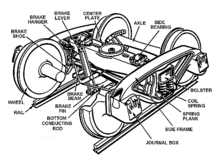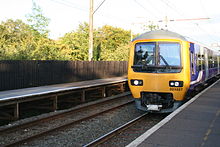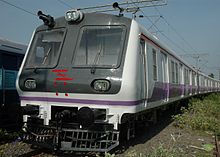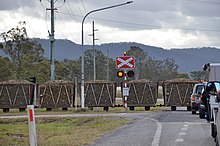This is an old revision of this page, as edited by 76.108.207.64 (talk) at 21:58, 17 November 2011 (→Types of trains). The present address (URL) is a permanent link to this revision, which may differ significantly from the current revision.
Revision as of 21:58, 17 November 2011 by 76.108.207.64 (talk) (→Types of trains)(diff) ← Previous revision | Latest revision (diff) | Newer revision → (diff) This article is about the vehicle. For other uses, see Train (disambiguation).| This article needs additional citations for verification. Please help improve this article by adding citations to reliable sources. Unsourced material may be challenged and removed. Find sources: "Train" – news · newspapers · books · scholar · JSTOR (March 2010) (Learn how and when to remove this message) |

| Part of a series on |
| Rail transport |
|---|
 |
|
|
| Infrastructure |
|
|
| Service and rolling stock |
|
| Urban rail transit |
|
|
| Miscellanea |
|
|
A train is a connected series of vehicles for rail transport that move along a track (permanent way) to transport cargo or passengers from one place to another place. The track usually consists of two rails, but might also be a monorail or maglev guideway.
Propulsion for the train is provided by a separate locomotive, or from individual motors in self-propelled multiple units. Most modern trains are powered by diesel locomotives or by electricity supplied by overhead wires or additional rails, although historically (from the early 19th century to the mid-20th century) the steam locomotive was the dominant form of locomotive power. Other sources of power (such as horses, rope or wire, gravity, pneumatics, batteries, and gas turbines) are possible.
The word 'train' comes from the Old French trahiner, itself from the Latin trahere 'pull, draw'.
trains
Bogies

A bogie (/ˈboʊɡi/ Template:USdict) is a wheeled wagon or trolley. In mechanics terms, a bogie is a chassis or framework carrying wheels, attached to a vehicle. It can be fixed in place, as on a cargo truck, mounted on a swivel, as on a railway carriage or locomotive, or sprung as in the suspension of a caterpillar tracked vehicle.
Motive power
Main article: LocomotiveThe first trains were rope-hauled, gravity powered or pulled by horses. From the early 19th century almost all were powered by steam locomotives. From the 1910s onwards the steam locomotives began to be replaced by less labour intensive and cleaner (but more complex and expensive) diesel locomotives and electric locomotives, while at about the same time self-propelled multiple unit vehicles of either power system became much more common in passenger service. In most countries dieselisation of locomotives in day-to-day use was completed by the 1970s. A few countries, most notably the People's Republic of China, where coal and labour are cheap, still use a few steam locomotives, but most have been phased out. Historic steam trains still run in many other countries, for the leisure and enthusiast market.
Electric traction offers a lower cost per mile of train operation but at a higher initial cost, which can only be justified on high traffic lines. Since the cost per mile of construction is much higher, electric traction is less viable for long-distance lines with the exception of long-distance high speed lines. Electric trains receive their current via overhead lines or through a third rail electric system.
A recent variation of the electric locomotive is the fuel cell locomotive. Fuel cell locomotives combine the advantage of not needing an electrical system in place, with the advantage of emissionless operation. However, the initial cost of such fuel cell vehicles is still substantial at the moment.
Passenger trains


A passenger train is one which includes passenger-carrying vehicles. It may be a self-powered multiple unit or railcar, or else a combination of one or more locomotives and one or more unpowered trailers known as coaches, cars or carriages. Passenger trains travel between stations or depots, at which passengers may board and disembark. In most cases, passenger trains operate on a fixed schedule and have superior track occupancy rights over freight trains.
Oversight of a passenger train is the responsibility of the conductor. He or she is usually assisted by other crew members, such as service attendants or porters. During the heyday of North American passenger rail travel, long distance trains carried two conductors: the aforementioned train conductor, and a Pullman conductor, the latter being in charge of sleeping car personnel.
Many prestigious passenger train services have been given a specific name, some of which have become famous in literature and fiction. In past years, railroaders often referred to passenger trains as the "varnish", alluding to the bygone days of wooden-bodied coaches with their lustrous exterior finishes and fancy livery. "Blocking the varnish" meant a slow-moving freight train was obstructing a fast passenger train, causing delays.
Some passenger trains, both long distance and short distanced, may use bi-level (double-decker) cars to carry more passengers per train. Car design and the general safety of passenger trains have dramatically evolved over time, making travel by rail remarkably safe.
Long-distance trains
Long-distance trains travel between many cities and/or regions of a country, and sometimes cross several countries. They often have a dining car or restaurant car to allow passengers to have a meal during the course of their journey. Trains travelling overnight may also have sleeping cars.
High-speed rail

One notable and growing long-distance train category is high-speed rail. Generally, high speed rail runs at speeds above 200 km/h (124 mph) and often operates on dedicated track that is surveyed and prepared to accommodate high speeds. Japan's Shinkansen ("bullet-train") commenced operation in 1964, and was the first successful example of a high speed passenger rail system.
The fastest wheeled train running on rails is France's TGV (Train à Grande Vitesse, literally "high speed train"), which achieved a speed of 574.8 km/h (357.2 mph), twice the takeoff speed of a Boeing 727 jetliner, under test conditions in 2007. The highest speed currently attained in scheduled revenue operation is 350 km/h (217 mph) on the Beijing–Tianjin Intercity Rail and Wuhan–Guangzhou High-Speed Railway systems in China. The TGV runs at a maximum revenue speed of 300–320 km/h (186–199 mph), as does Germany's Inter-City Express.
In most cases, high-speed rail travel is time- and cost-competitive with air travel when distances do not exceed 500 to 600 km (311 to 373 mi), as airport check-in and boarding procedures may add as many as two hours to the actual transit time. Also, rail operating costs over these distances may be lower when the amount of fuel consumed by an airliner during takeoff and climbout is considered. As travel distance increases, the latter consideration becomes less of the total cost of operating an airliner and air travel becomes more cost-competitive.
Some high speed rail equipment employs tilting technology to improve stability in curves. Examples of such equipment are the Advanced Passenger Train (APT), the Pendolino, the N700 Series Shinkansen, Amtrak's Acela Express and the Talgo. Tilting is a dynamic form of superelevation, allowing both low- and high-speed traffic to use the same trackage (though not simultaneously, of course), as well as producing a more comfortable ride for passengers.
Maglev
Main article: Maglev (transport)In order to achieve much faster operation over 500 km/h (310 mph), innovative Maglev technology has been researched for years. The Shanghai Maglev Train, opened in 2003, is the fastest commercial train service of any kind, operating at speeds of up to 430 km/h (270 mph). So far, however, Maglev has not been used for inter-city mass transit routes.
Inter-city trains
Main article: Inter-city railPassenger trains can be divided into three major groups:
- Intercity trains: connecting cities in the fastest time possible, by passing all intermediate stations
- Fast trains: calling at larger intermediate stations between cities, serving large urban communities
- Regional trains: calling at all intermediate stations between cities, serving all lineside communities
The distinction between the types can be thin or even non-existent. Trains can run as Intercity services between major cities, then revert to a fast or even regional train service to serve communities at the extremity of their journey. This practice allows marginal communities remaining to be served while saving money at the expense of a longer journey time for those wishing to travel to the terminus station.
Regional trains
Main article: Regional railRegional trains usually connect between towns and cities, rather than purely linking major population hubs like inter-city train, and serve local traffic demand in relatively rural area.
Short-distance trains
Commuter trains


For shorter distances many cities have networks of commuter trains, serving the city and its suburbs. Trains are a very efficient mode of transportation to cope with large traffic demand in a metropolis. Compared with road transport, it carries many people with much smaller land area and little air pollution.
Some carriages may be laid out to have more standing room than seats, or to facilitate the carrying of prams, cycles or wheelchairs. Some countries have double-decked passenger trains for use in conurbations. Double deck high speed and sleeper trains are becoming more common in mainland Europe.
Sometimes extreme congestion of commuter trains becomes a problem. For example, an estimated 3.5 million passengers ride every day on Yamanote Line in Tokyo, Japan, with its 29 stations. For comparison, the New York City Subway carries 4.8 million passengers per day on 24 services serving 468 stations. To cope with large traffic, special cars in which the bench seats fold up to provide standing room only during the morning rush hour (until 10 a.m.) are operated in Tokyo (E231 series train). In the past this train has included 2 cars with six doors on each side to shorten the time for passengers to get on and off at station.
Passenger trains usually have emergency brake handles (or a "communication cord") that the public can operate. Misuse is punished by a heavy fine.
Rapid transit
Main articles: Commuter rail in North America, Commuter rail, Rapid transit, and Urban rail in the United KingdomLarge cities often have a metro system, also called underground, subway or tube. The trains are electrically powered, usually by third rail, and their railroads are separate from other traffic, usually without level crossings. Usually they run in tunnels in the city centre and sometimes on elevated structures in the outer parts of the city. They can accelerate and decelerate faster than heavier, long-distance trains.
The term rapid transit is used for public transport such as commuter trains, metro and light rail. However, in New York City, services on the New York City Subway have been referred to as "trains".
Tram
Main article: TramIn most countries, such as the United Kingdom, the distinction between a tramway and a railway is precise and defined in law. In the US and Canada such street railways are mostly referred to as trolleys. The key difference between a railroad and a trolley system is the latter running primarily on public streets, whereas trains have a right of way separated from the public. Often the US style interurban and modern light rail are confused with a trolley system, as it too may run on on the street for short or medium long sections. In some languages the word tram also refers to interurban and light rail -style networks, in particular Dutch.
The length of a tram or trolley may be determined by national regulations. Germany has the so-called Bo-Strab standard, restricting the length of a tram to 75 metres, while in the US, vehicle length is normally restricted by local authorities, often allowing only a single type of vehicle to operate on the network.
Light rail
Main article: Light railThe term light rail is sometimes used for a modern tram system, but it may also mean an intermediate form between a tram and a train, similar to a subway except that it may have level crossings. These are then usually protected with crossing gates. In US terminology these systems are often referred to as interurban, as they connect larger urban areas in the vicinity of a major city to that city. Modern light rail systems often use abandoned heavy rail rights of way (e.g. former railway lines) to revitalize deprived areas and redevelopment sites in and around large agglomerations.
Monorail
Main article: MonorailMonorail was developed to meet medium-demand traffic in urban transit, but represents a relatively small part of the overall railway field.
Named trains
See also: Lists of named passenger trainsRailway companies often give a name to a train service as a marketing exercise, to raise the profile of the service and hence attract more passengers (and also to gain kudos for the company). Usually, naming is reserved for the most prestigious trains: the high-speed express trains between major cities, stopping at few intermediate stations. The names of services such as the Orient Express, the Flying Scotsman, the Flèche d'Or and the Royal Scot have passed into popular culture.
A somewhat less common practice is the naming of freight trains, for the same commercial reasons. The "Condor" was an overnight London-Glasgow express goods train, in the 1960s, hauled by pairs of "Metrovick" diesel locomotives. In the mid-1960s, British Rail introduced the "Freightliner" brand, for the new train services carrying containers between dedicated terminals around the rail network. The Rev. W. Awdry also named freight trains, coining the term The Flying Kipper for the overnight express fish train that appeared in his stories in The Railway Series books.
Other types
- Heritage trains
Heritage trains are operated by volunteers, often railfans, as a tourist attraction. Usually trains are formed from historic vehicles retired from national commercial operation.
- Airport trains
Airport trains transport people between terminals within an airport complex.
- Mine trains
Mine trains are operated in large mines and carry both workers and goods.
- Overland trains
Overland trains are used to carry cargo over rough terrain.
Freight trains
Main article: Freight rail transport


A freight train (also known as goods train) uses freight cars (also known as wagons or trucks) to transport goods or materials (cargo) – essentially any train that is not used for carrying passengers. Much of the world's freight is transported by train, and in the United States the rail system is used more for transporting freight than passengers.
Under the right circumstances, transporting freight by train is highly economic, and also more energy efficient than transporting freight by road. Rail freight is most economic when freight is being carried in bulk and over long distances, but is less suited to short distances and small loads. Bulk aggregate movements of a mere twenty miles (32 km) can be cost effective even allowing for trans-shipment costs. These trans-shipment costs dominate in many cases and many modern practices such as Intermodal container freight are aimed at minimizing these.
The main disadvantage of rail freight is its lack of flexibility. For this reason, rail has lost much of the freight business to road competition. Many governments are now trying to encourage more freight onto trains, because of the benefits that it would bring.
There are many different types of freight trains, which are used to carry many different kinds of freight, with many different types of wagons. One of the most common types on modern railways are container trains, where containers can be lifted on and off the train by cranes and loaded off or onto trucks or ships.
In the U.S. this type of freight train has largely superseded the traditional boxcar (wagon-load) type of freight train, with which the cargo has to be loaded or unloaded manually. In Europe the sliding wall wagon has taken over from the ordinary covered goods wagon.
In some countries "piggy-back" trains or rolling highways are used: In the latter case trucks can drive straight onto the train and drive off again when the end destination is reached. A system like this is used through the Channel Tunnel between England and France, and for the trans-Alpine service between France and Italy (this service uses Modalohr road trailer carriers). "Piggy-back" trains are the fastest growing type of freight trains in the United States, where they are also known as "trailer on flatcar" or TOFC trains. Piggy-back trains require no special modifications to the vehicles being carried. An alternative type of "inter-modal" vehicle, known as a roadrailer, is designed to be physically attached to the train. The original trailers were fitted with two sets of wheels — one set flanged, for the trailer to run connected to other such trailers as a rail vehicle in a train; and one set tyred, for use as the semi-trailer of a road vehicle. More modern trailers have only road wheels and are designed to be carried on specially adapted bogies (trucks) when moving on rails.
There are also many other types of wagons, such as "low loader" wagons for transporting road vehicles. There are refrigerator cars for transporting foods such as ice cream. There are simple types of open-topped wagons for transporting minerals and bulk material such as coal, and tankers for transporting liquids and gases. Today, however, most coal and aggregates are moved in hopper wagons that can be filled and discharged rapidly, to enable efficient handling of the materials.
Freight trains are sometimes illegally boarded by passengers who do not wish to pay money, or do not have the money to travel by ordinary means. This is referred to as "freighthopping" and is considered by some communities to be a viable form of transport. A common way of boarding the train illegally is by sneaking into a train yard and stowing away in an unattended boxcar; a more dangerous practice is trying to catch a train "on the fly", that is, as it is moving, leading to occasional fatalities. Railroads treat it as trespassing and may prosecute it as such.
Trains in popular culture
See:
- Rail transport in fiction
- List of train songs
- Toy train
- Train game
- Rail transport modelling
- Category:Train simulation video games
See also
- Armoured train
- Famous trains
- Luxury trains
- Headboard (train)
- Heaviest trains
- History of rail transport
- Hydrail
- List of railway companies
- Monorail
- Rocket sled – rail mounted rockets
- Trains portal
- Unit train
Rail accidents
References
- "Train (noun)". (definition – Compact OED). Oxford University Press. Retrieved 2008-03-18.
- Hydrogen trains
- Vehicle Projects Inc. Fuel cell locomotive
- Central Japan Railway (2006). Central Japan Railway Data Book 2006. p. 16.
- "Overview Of the existing Mumbai Suburban Railway". Official webpage of Mumbai Railway Vikas Corporation. Archived from the original on 2008-06-20. Retrieved 2008-12-11.
Further reading
- Glancey, Jonathan (2005). "The Train" (Document). Carlton Publishing Group.
{{cite document}}: Unknown parameter|isbn=ignored (help), 256 pp.
External links
[REDACTED] Media related to Trains at Wikimedia Commons
Categories: